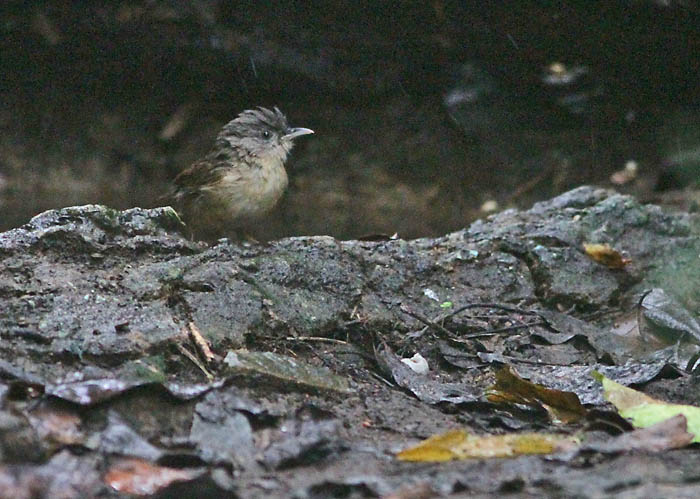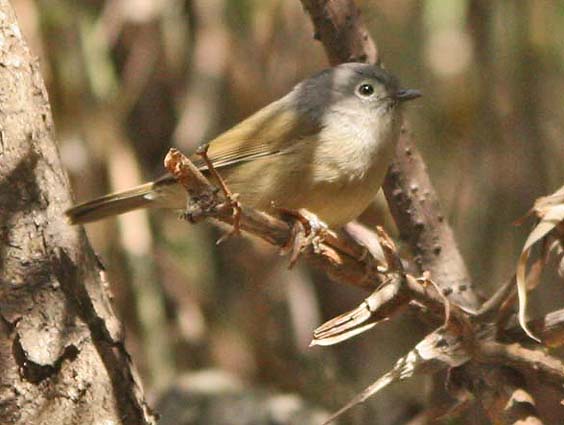
a web page by Don Roberson |
ALCIPPE FULVETTAS Alcippeidae |
|
Now, new evidence suggests that fulvettas in genus Alcippe should be elevated to their own family [Alcippeidae]. One of those species is Brown-cheeked Fulvetta of south Asia (left or above), shown with its crest erected after emerging from a bath in a forest waterhole. At another time, I recall watching a very dull Brown-cheeked Fulvettain Assam, India, transform itself into a thing of beauty by lustily giving a complex song from a song perch low in the undergrowth of Panbari Forest. |
Among the important works that sorted-out the babblers up to this point are Cibois (2003), Barker et al. (2004), Alström et al. (2006), Gelang et al. (2009), Cibois et al. (2010), and Moyle et al. (2012). The newest review is by Cai et al. (2019), entitled "Near-complete phylogeny and taxonomic revision of the world’s babblers," and there are many familiar names among the 13 authores. The new work is derived from a molecular study of 402 species (~89% of all babblers) from 75 genera (97%). Their results identified seven major clades — including the split of the Sylviidae from the Paradoxornithidae (Parrotbills & allies) that both this on-line project and Clements/eBird adopted some years ago. Cai et al. (2018) found that "divergence time estimates indicate that the seven major clades diverged around the same time (18-20 million years ago) in the early Miocene. We use the phylogeny in a consistent way to propose a new taxonomy, with seven families and 64 genera of babblers." The seventh and newest family is composed of the 12 species in genus Alcippe. Previously, separate studies placed the Alcippe fulvettas in the Pellorneidae or the Leiothrichidae, without strong support either way (Gelang et al. 2009, Moyle et al. 2012). Cai et al. (2019) state that "because the divergence between these three clades occurred early during the Miocene, we suggest the genus Alcippe Blyth, 1844 be placed in a separate family." But then the authors confront an unusual taxonomic problem — there is already a formal family called the Alcippidae (which would be the normal spelling for this new family of birds:
And so we have now a family of birds [Alcippeidae] and a family of marine invertebrates [Alcippidae]. |
The etymology of the name reads: "In the Greek mythology, Alcippe is the daughter of Ares and Aglauros." The 12 species currently accepted by Clements are widely scattered in south Asia: Gold-fronted Fulvetta A. variegaticeps, Ludlow's Fulvetta A. ludlowi, Brown Fulvetta A. brunneicauda, Brown-cheeked Fulvetta A. poioicephala, Morrison's Fulvetta A. morrisonia, Yunnan Fulvetta A. fratercula, David's Fulvetta A. davidi, Huet's Fulvetta A. hueti, Javan Fulvetta A. pyrrhoptera, Mountain Fulvetta A. peracensis, Nepal Fulvetta A. nipalensis, and Black-browed Fulvetta A. grotei. The Alcippe Fulvettas are small, arboreal forest birds, ranging in a variety of forests from lowlands to mountains. They are often in mixed-species flocks. Whitle the Brown-cheeked Fulvetta, shown at the top of this page, is widespread from India throughout southeast Asia, Javan Fulvetta (right) is restricted to montane forests on Java. |
David's Fulvetta is a common component of mixed species flocks in central China. [Another component of those flocks — Golden-breasted Fulvetta, formerly "Alcippe chrysotis" — is now in its own genus Lioparus and assigned to the Parrotbills.] |
Photos: The Brown-cheeked Fulvetta Alcippe poioicephala was photographed from a hide near Kaeng Krachen NP, Thailand, on 20 Dec 2012. The Javan Fulvetta Alcippe pyrrhoptera was at Gunung Gede Pangrango NP, Java, Indonesia, on 29 Aug 1988. David's Fulvetta Alcippe davidi was photographed at Foping Nature Reserve, Shaanxii, China, on 15 Nov 2010. All text and photos © Don Roberson, and may not be used without permission. Bibliographic note: There is no "family book" per se, but a introduction to this family, when it was embedded in the Babbles, is in Collar & Robson (2007). Literature cited:
|
 Old
World babblers, one of the largest traditional bird families, has been
the subject of a series of important molecular papers early in this
century that totally unraveled prior conventional wisdom. From a single
huge family of 309 species in the traditional sense (e.g., Collar &
Robson 2007), most world checklists now recognize 5 or 6 families. A
particularly hard-hit set of Asian species were the fulvettas. Eight
species in genus Fulvetta were assigned to the Parrotbill family Paradoxornithidae. Six species in genus Schoeniparus were assigned to the Pellorneidae, and 12 species in genus Alcippe were initally talled there as well, but were more recently sent to the Leiothrichidae (Laughingthrushes).
Old
World babblers, one of the largest traditional bird families, has been
the subject of a series of important molecular papers early in this
century that totally unraveled prior conventional wisdom. From a single
huge family of 309 species in the traditional sense (e.g., Collar &
Robson 2007), most world checklists now recognize 5 or 6 families. A
particularly hard-hit set of Asian species were the fulvettas. Eight
species in genus Fulvetta were assigned to the Parrotbill family Paradoxornithidae. Six species in genus Schoeniparus were assigned to the Pellorneidae, and 12 species in genus Alcippe were initally talled there as well, but were more recently sent to the Leiothrichidae (Laughingthrushes).  Cai
et al. (2019) give the "diagnosis" of the new family of birds as "A
group of small birds, 12.5–16.5 cm in length, 13.2–18.3 g, with brown
or olive-grey upperparts, wings and tail, buffy- white underparts,
brown or grey crown, nape and ear-coverts, and often white eye-ring and
blackish lateral crownstripes. Sexes similar. The species in
Alcippeidae are smaller than those in the Leiothrichidae
(laughingthrushes and allies), with duller plumage. They are more
arboreal in habits than the Pellorneidae, which have stronger legs."
Cai
et al. (2019) give the "diagnosis" of the new family of birds as "A
group of small birds, 12.5–16.5 cm in length, 13.2–18.3 g, with brown
or olive-grey upperparts, wings and tail, buffy- white underparts,
brown or grey crown, nape and ear-coverts, and often white eye-ring and
blackish lateral crownstripes. Sexes similar. The species in
Alcippeidae are smaller than those in the Leiothrichidae
(laughingthrushes and allies), with duller plumage. They are more
arboreal in habits than the Pellorneidae, which have stronger legs." The fulvetta genus Alcippe
once contained 17 species but research (Moyle et al. 2012) showed that
not only was the genus paraphyletic, its members belonged to two or
three families. Those now assigned to genus Schoeniparus are now among the Pellorneidae. The 12 remaining members of genus Alcippe,
now located here as their own Family, include what used to be called
"Gray-cheeked Fulvetta" (left). However, "Gray-cheeked Fulvetta" is
itself a group of four different species (Zou et al. 2007, Song et al.
2009). This photo is of the taxa now called David's Fulvetta [nominate morrisonia is now restricted to Taiwan].
The fulvetta genus Alcippe
once contained 17 species but research (Moyle et al. 2012) showed that
not only was the genus paraphyletic, its members belonged to two or
three families. Those now assigned to genus Schoeniparus are now among the Pellorneidae. The 12 remaining members of genus Alcippe,
now located here as their own Family, include what used to be called
"Gray-cheeked Fulvetta" (left). However, "Gray-cheeked Fulvetta" is
itself a group of four different species (Zou et al. 2007, Song et al.
2009). This photo is of the taxa now called David's Fulvetta [nominate morrisonia is now restricted to Taiwan].